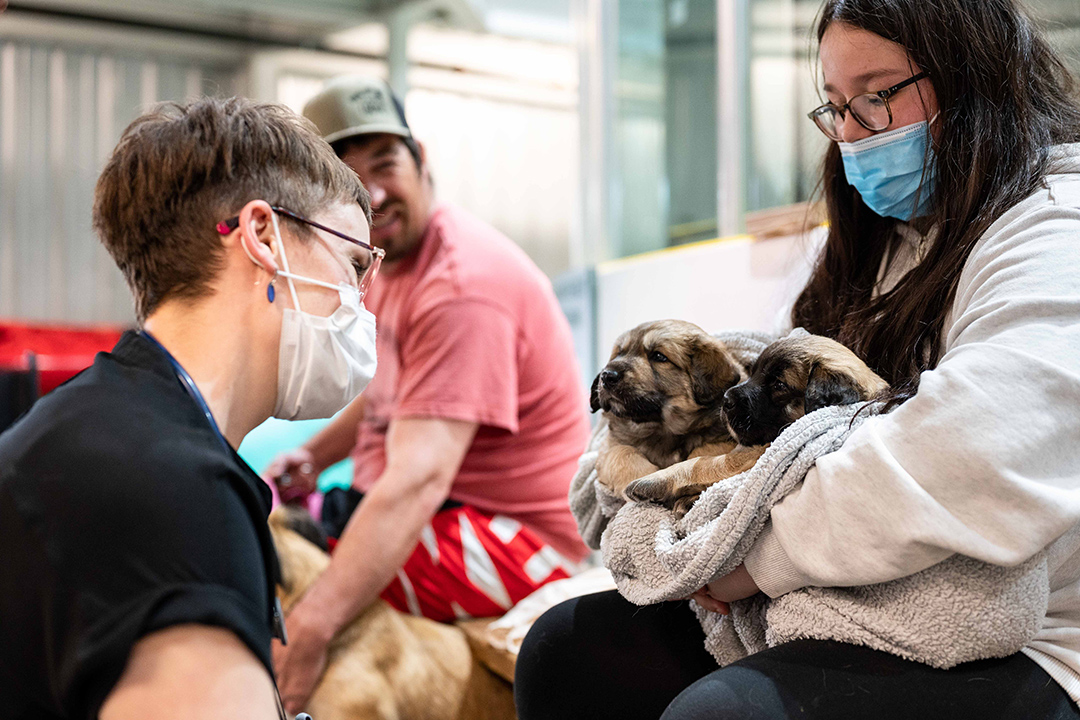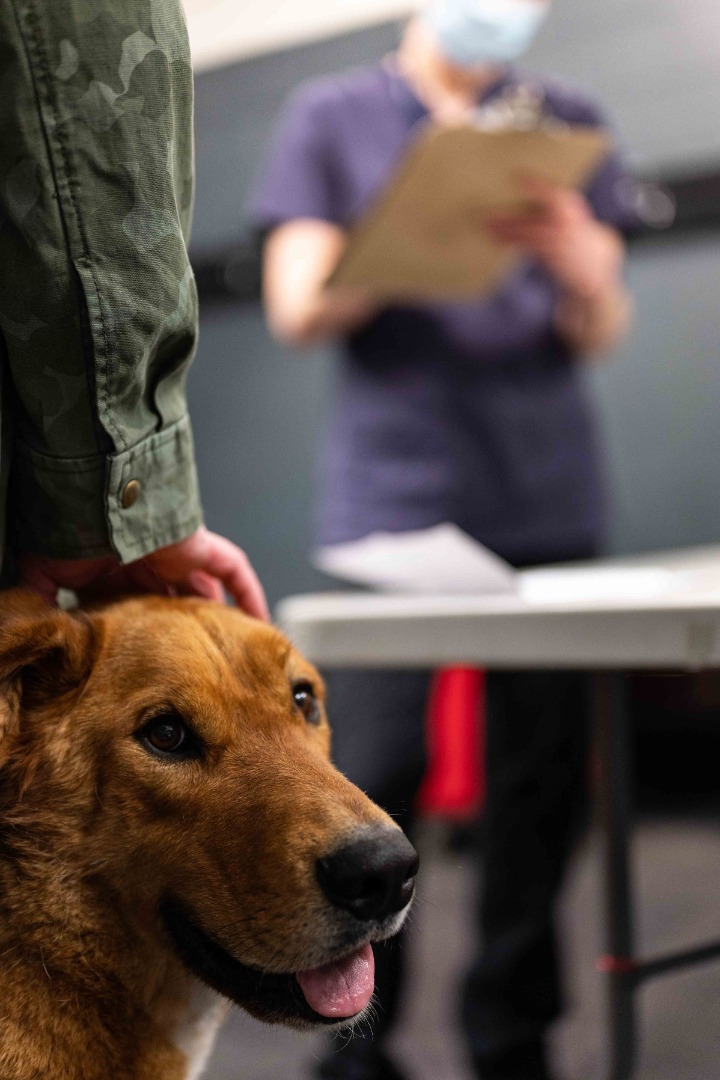
SHRF supports USask study targeting dog-human interactions in remote communities
Over $149,000 in funding from the Saskatchewan Health Research Foundation (SHRF) is helping University of Saskatchewan (USask) researchers from multiple disciplines provide support to Saskatchewan communities that are experiencing challenges with dogs.
By Cat Zens
The SHRF-funded research project uses a One Health approach to study human-dog relationships and circumstances surrounding aggressive dog-human encounters such as dog bites. With this approach, researchers explore the human and animal contributors to dog issues in communities, and they hope to better understand risk factors for dog bites and other dangerous encounters with dogs.
Using existing tools, communities can also access support in identifying their unique needs regarding dogs and the dog-human interface as part of this project. The ultimate goal is to identify and begin developing strategies to meet the needs of rural, remote and Indigenous communities in identifying local dog issues.
This study is part of SHRF’s Solutions Program, which supports collaborative research projects that respond to pressing health challenges in Saskatchewan.
Dr. Tasha Epp (DVM, PhD) is the project’s principal investigator and a professor of epidemiology at the Western College of Veterinary Medicine (WCVM). She’s grateful for SHRF’s support, given the project's benefits to both animal and human health.
“On the veterinary side, it’s harder to sell to a simply animal-related granting agency that you want to do something that impacts human health,” she says. “Now that we are accessing bigger funding sources, we have better accessibility and better ability to do the research.”
Epp ultimately wants to look at ways to prevent dog-aggressive encounters, including dog bites, in communities that lack access to veterinary services. To help address these issues, her team consists of USask- and community-based researchers who work in various disciplines.
WCVM researchers Drs. Jordan Woodsworth (DVM) and Karen Machin (DVM, PhD) add further veterinary expertise to the team. From the human health perspective, Drs. Nnamdi Ndubuka (MBBS, PhD) and Ibrahim Khan (MPH) are associate members of the university’s College of Medicine. As well, Ndubuka is medical health officer for the Northern Inter-Tribal Health Authority (NITHA) and Khan serves as medical health officer for the First Nations Inuit Health Branch (FNIHB) of Indigenous Services Canada.
Two additional collaborators bring a nursing point of view to the project: Dr. Holly Graham (PhD) is the USask Indigenous Research Chair in Nursing while Lisa Mayotte is a public health nursing manager with Lac La Ronge Indian Band Health Services.
Woodsworth is the project’s co-principal investigator who recently completed a PhD at the WCVM. Her recently published dissertation, supervised by Epp, employed Indigenous and Western research approaches within a community-oriented case study to explore and illustrate dog-human relationships as well as dog care and control in the northern Saskatchewan tri-community area of La Ronge, Air Ronge and Lac La Ronge Indian Band.
Woodsworth’s previous work inspired her to pursue additional research that builds on her team’s findings.
“In the course of doing [my doctoral research], we identified a number of different gaps and one of them was around how to manage the safety of the dog-human relationship in communities.”

Woodsworth notes that communities with limited access to veterinary services experience risks to dog and human health related to limited vaccination coverage in the dog population. There’s also an increased tendency for dogs to roam and compete for resources such as food and mates when they remain sexually intact.
In 2018, Epp co-authored The Community Dog Workbook with Dr. Jasmine Dhillon (DVM, PhD). This booklet, which can be accessed online, is designed to help communities identify their unique needs about dog management and work toward achieving short-, medium- and long-term goals in this area.
As part of the SHRF funded project, Epp’s research team is positioned to provide support to communities in using this resource.
“Some communities felt like it was a lot for them to step in and [work through the book] themselves,” Epp says. “In this grant, we put in a component in which we will work with the communities. It helps us understand what they need, what they’re lacking, and it helps us continue with our research and continue providing extra resources.”
Access to veterinary care and related challenges with dogs in rural, remote and Indigenous communities are complex issues with no simple solutions. Without easy access to veterinary clinics, creative alternatives to the usual model of providing animal health care are necessary. WCVM researchers anticipate that this project will enable them to identify opportunities and develop alternatives with partner communities that specifically work for these communities.
Collaborative exploration and development of innovative solutions with communities isn’t new to the WCVM. Epp highlights the one-day dog house and fence building workshop that senior veterinary students took part in this spring.
The students used wooden pallets to build the structures, a design suggested by a member of a First Nation close to Saskatoon. This creative option could improve access to sustainable solutions for restraint and shelter for dogs that were previously roaming free in the community.
“It’s really just trying to think outside the box: instead of just … reacting to dog aggressive encounters after they occur, let’s try to be more preventive or proactive.”
Epp adds that public health personnel spend a lot of time dealing with dog bites — particularly managing the risk of rabies transmission — but they aren't trained from an animal health perspective. Epp’s research team hopes to better understand why dogs bite so more effective preventive and interventive strategies can be developed and applied.
“If you have healthy dog-human interactions, you’ll have healthier communities,” Epp says.
The study is open to any community in Saskatchewan that experiences dog-related issues such as dog bites and free-roaming dogs. Communities wishing for expert assistance in managing dog-related issues are encouraged to reach out to Epp’s research team to learn more about enrolling in the study (healthydogs.healthycommunities@usask.ca).
Click here for additional information about Woodsworth’s doctoral research.
